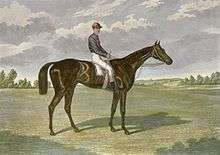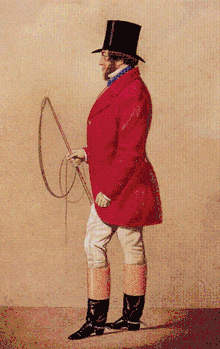Favonius (horse)
Favonius (1868–1877) was a British Thoroughbred racehorse and sire. In a career that lasted from 1871 to 1873 he ran ten times and won five races. In June 1871 he won The Derby on his second racecourse appearance. He went on to prove himself a top class stayer, winning the Goodwood Cup in 1872. Favonius was regarded by contemporary observers as one of the best English-trained horses of his era. At the end of the 1873 season he was retired to stud but had little chance to make an impact as a stallion before his death four years later. Favonius’s Derby win was one of the highlights of what became known as “The Baron’s Year”, in which his owner, Baron Meyer de Rothschild won four of the five British Classic Races.
| Favonius | |
|---|---|
 Engraving of Favonius | |
| Sire | Parmesan |
| Grandsire | Sweetmeat |
| Dam | Zephyr |
| Damsire | King Tom |
| Sex | Stallion |
| Foaled | 1868 |
| Country | United Kingdom of Great Britain and Ireland |
| Colour | Chestnut |
| Owner | Meyer de Rothschild |
| Trainer | Joseph Hayhoe |
| Record | 11: 5-4-0 |
| Earnings | £ |
| Major wins | |
| Epsom Derby (1871) Goodwood Cup (1872) | |
Background
Favonius was bred by his owner, Baron Meyer de Rothschild. He was sired by Parmesan, a male-line descendant of the Byerley Turk. Parmesan won the Gold Vase at Royal Ascot and became a highly successful stallion siring, in addition to Favonius, the 1871 Derby winner Cremorne.[1] Favonius’s dam Zephyr, was a full sister to Hannah,[2] who won the Fillies’ Triple Crown in “The Baron’s Year”.[3]
Rothschild sent the colt to his private trainer Joseph Hayhoe at his Palace House stables at Newmarket, Suffolk. Until 1946, British racehorses were allowed to race without being officially named, and until shortly before his Derby win, Favonius was known as “The Zephyr Colt”.
Racing career
1871: three-year-old season
The Zephyr Colt was slow to mature and did not race as a two-year-old. He made his debut in the spring of 1871 in a Biennial Stakes at Newmarket. He was beaten a head by Albert Victor.[4] In mid-May Hayhoe tried the colt in a private trial race against Hannah, which convinced him that the colt was sixteen pounds superior to the filly.[3]

In the Derby at Epsom, the newly named colt started at odds of 9/1 in a field of seventeen runners, with Bothwell being made the 2/1 favourite. The appearance of the name "Favonius" on the race card reportedly caused some confusion among racegoers who were unaware that the Baron had decided to name the Zephyr Colt after the personification of the West Wind. The crowd included the Prince of Wales who viewed the race from a private stand near the judge's chair.[5] Ridden by Tom French, Favonius made little show in the early stages, but moved up to track the leaders entering the straight. He made steady progress to take the lead inside the final furlong and won easily[6] by one and a half lengths from Albert Victor and King of the Forest who dead-heated for second place. The win was extremely popular with the huge crowd, and the Baron, identifiable by his white hat was mobbed by wellwishers as he attempted to return to his carriage.[5] Rothschild was reported to have given £1,000 to Tom French for his ride on Favonius, with an additional £200 annuity for life.[7]
In July, Favonius won the Midsummer Stakes at Newmarket. On 27 July he ran in a much anticipated race for the Goodwood Cup in which he has matched against the French-trained Ascot Gold Cup winner Mortemer.[8] Favonius defeated the French horse, but was beaten half a length in a "most sensational race" by the 50/1 outsider Shannon to whom he was conceding ten pounds[9] The very slow pace at which the race was run in the early stages led some commentators to consider the result a "fluke".[10] In the Brighton Cup over two miles, Favonius started 4/6 favourite and won easily by three lengths.[11]
Favonius had not been entered for the St Leger[12] and did not race again until October when he appeared at Newmarket. In the Cambridgeshire Handicap he finished unplaced carrying a weight of 123 pounds. He walked over at Newmarket later in the month, after only rival, Sterling, was withdrawn to pursue a match against the American champion Harry Bassett.[4][13]
Favonius's winning prize money of £5,900 contributed towards Baron Rothschild being the leading owner of 1871.[14]
1872: four-year-old season
In 1872, Favonius was aimed at the major staying races. Early in the year, Rothschild had reportedly turned down an offer of £12,000 for the colt.[15] On his first start of the year he easily defeated Dutch Skater in a two-mile race at Newmarket in May. At Ascot in June he started 2/5 favourite for the Gold Cup in front of a crowd which included the Prince of Wales and many other members of the British aristocracy. He looked impressive in the paddock and took the lead in the straight but was beaten by the French colt Henry.[16] Two days later he ran in the Alexandra Plate over three miles and finished fourth behind Musket[17]
In July he ran in his second Goodwood Cup and produced one of his best performances, taking the lead early in the straight and drawing clear to win by ten lengths from Albert Victor. [18]
Assessment
In May 1886 The Sporting Times carried out a poll of one hundred racing experts to create a ranking of the best British racehorses of the 19th century. Favonius was ranked thirty-third, having been placed in the top ten by seven of the contributors. He was the third highest-placed Derby winner of the 1870s and the sixth highest British horse of his decade behind Isonomy.[20]
Stud career
Favonius was retired to his owner’s Mentmore stud. He stood for only four seasons before his death from a form of "Typhoid fever" in August 1877 when he was valued at £12,000.[21] His most notable offspring was Sir Bevys, who won the Derby in 1879.
Pedigree
| Sire Parmesan (GB) 1857 |
Sweetmeat 1842 |
Gladiator | Partisan |
|---|---|---|---|
| Pauline | |||
| Lollypop | Voltaire | ||
| Belinda | |||
| Gruyere 1851 |
Verulam | Lottery | |
| Wire | |||
| Jennala | Touchstone | ||
| Emma | |||
| Dam Zephyr (GB) 1862 |
King Tom 1851 |
Harkaway | Economist |
| Fanny Dawson | |||
| Pocahontas | Glencoe | ||
| Marpessa | |||
| Mentmore Lass 1850 |
Melbourne | Humphrey Clinker | |
| Cervantes mare | |||
| Emerald | Defence | ||
| Emiliana (Family: 3-c)[23] |
Sire line tree
References
- "SPORTING NOTES". Otago Witness. 21 September 1872. Retrieved 2011-12-23.
- "Local and General". Star. 17 July 1871. Retrieved 2011-12-23.
- Mortimer, Roger; Onslow, Richard; Willett, Peter (1978). Biographical Encyclopedia of British Flat Racing. Macdonald and Jane’s. ISBN 0-354-08536-0.
- "THE HERO OF THE SEASON". Australian Town & Country Journal. 9 Mar 1872. Retrieved 2011-12-23.
- "THE DERBY". West Coast Times. 16 August 1871. Retrieved 2011-12-23.
- "SPORTING INTELLIGENCE". Taranaki Herald. 29 July 1871. Retrieved 2011-12-23.
- "Papers Past — Daily Southern Cross". The Daily Southern Cross. 22 August 1871. Retrieved 2011-12-23.
- "ENGLISH SPORTING. THE TURF. BRIGHTON". The Empire (Sydney). 16 Oct 1871. Retrieved 2011-12-23.
- "GOODWOOD RACES". Sydney Morning Herald. 29 Sep 1871. Retrieved 2011-12-23.
- "GOODWOOD RACES". Maitland Mercury & Hunter River General Advertiser. 30 Sep 1871. Retrieved 2011-12-23.
- "English Sporting. THE TURF. BRIGHTON". Australian Town and Country Journal. 14 Oct 1871. Retrieved 2011-12-23.
- "RANDWICK SPRING MEETING". Nelson Examiner and New Zealand Chronicle. 23 September 1871. Retrieved 2011-12-23.
- "Local and General". Star. 19 January 1872. Retrieved 2011-12-23.
- "PRINCIPAL, WINNING OWNERS IN 1871". Australian Town and Country Journal. 24 Feb 1872. Retrieved 2011-12-23.
- "HINTS TO SPORTSMEN". Bruce Herald. 31 July 1872. Retrieved 2011-12-23.
- "THE CUP DAY AT ASCOT". North Otago Times. 20 August 1872. Retrieved 2011-12-23.
- "English Turf Items. ASCOT RACES". Australian Town and Country Journal. 14 Sep 1872. Retrieved 2011-12-23.
- "English Turf. GOODWOOD RACES". Australian Town and Country Journal. 28 Sep 1872. Retrieved 2011-12-23.
- "ENGLISH TELEGRAMS". Auckland Star. 8 August 1873. Retrieved 2011-12-23.
- Morris, Tony; Randall, John (1990). Horse Racing: Records, Facts, Champions(Third Edition). Guinness Publishing. ISBN 0-85112-902-1.
- British Veterinary Journal. Books.google.co.uk. 2009-11-05. Retrieved 2013-05-03.
- "Favonius pedigree". equineline.com. 2012-05-08. Retrieved 2013-05-03.
- "Thoroughbred Bloodlines - Whisker Mare - Family 3-c". Bloodlines.net. Retrieved 2013-05-03.
- Byerley Turk Line
- Highflyer Sire Line
- Sweetmeat
- Parmasan
- Talk of the Day